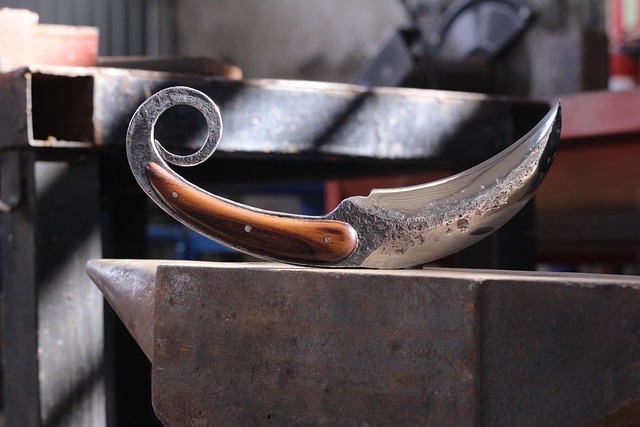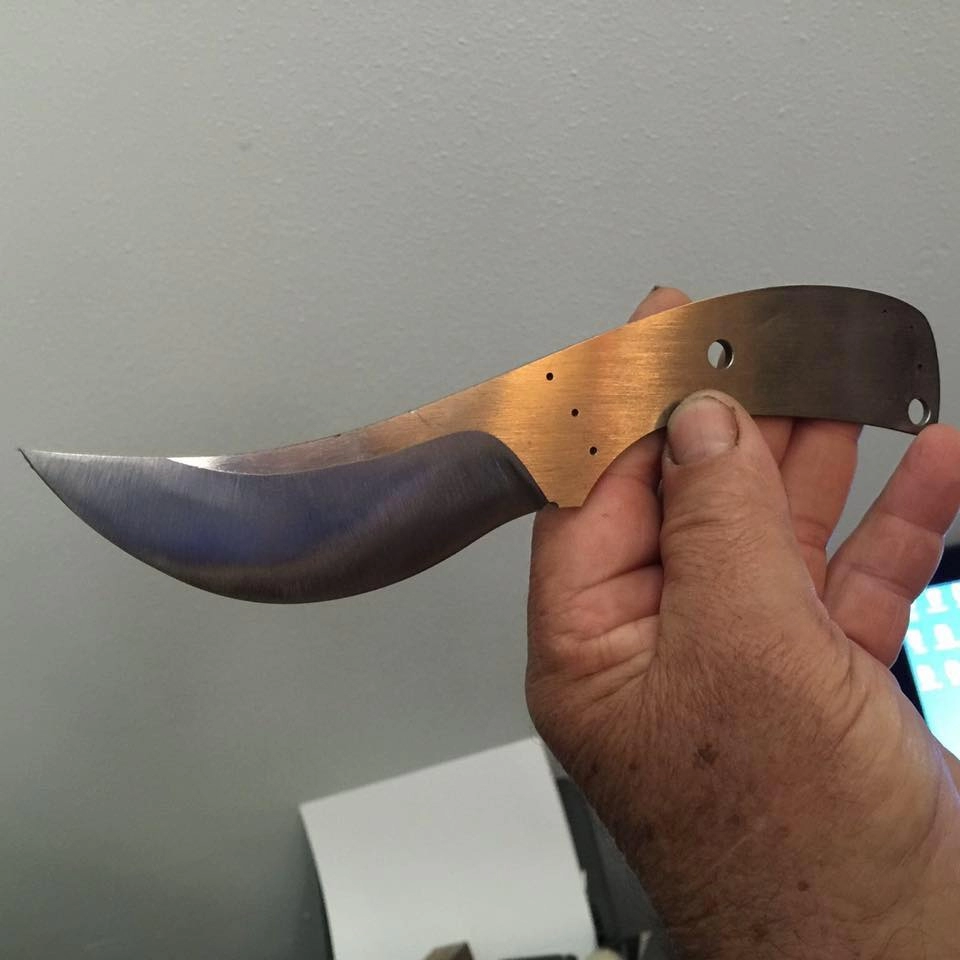By Super Admin - 5 May 2023
Knives with Curved Blades
Learn everything you need to know about knives with curved blades in our comprehensive guide. Find the perfect curved blade knife for your needs today.

Knives with curved blades have been around for centuries and are known for their unique design that makes them stand out from other knives. These types of knives are particularly useful for cutting tasks that require a slicing motion, such as chopping vegetables or carving meat. The curved shape of the blade allows for more efficient and precise cutting, making it a favorite tool among chefs, hunters, and martial artists. In this article, we will explore the history, anatomy, advantages, and cultural significance of knives with curved blades, as well as provide tips on how to choose and use them properly. Knives with curved blades have been around for centuries and have been used for various purposes. The earliest curved blade knives can be traced back to ancient civilizations like the Greeks and the Egyptians. These knives were primarily used for hunting and warfare. In Asia, curved blade knives were used in combat and martial arts. The curved shape allowed the user to inflict deep wounds, and it was also useful for slashing and hooking movements. In modern times, curved blade knives have evolved into specialized tools used for various tasks, including food preparation, hunting, and self-defense. Curved blade knives are incredibly versatile and can be used for a wide range of tasks. They are perfect for chopping, slicing, and mincing vegetables, fruits, and meats. They are also ideal for cutting through tough materials like bones and tendons. The curved shape of the blade provides better cutting performance compared to straight blades. The curved edge creates a rocking motion that allows for effortless cutting, while the sharp point is perfect for piercing and slicing. The curved shape of the blade also makes it easier to control the knife. The user can use their wrist to guide the knife's motion, which is useful for precise cuts and intricate designs. The karambit is a small, curved-blade knife that originated in Southeast Asia. It is typically used in martial arts and self-defense. The Kitsune is a Japanese knife with a curved blade that is used for slicing and chopping. It is also suitable for delicate tasks like filleting fish. The kukri is a Nepalese knife with a curved blade that is used for hunting and warfare. It is also a popular tool for chopping firewood. The scythe is a curved blade knife that is used for harvesting crops. It is commonly used in farming and agriculture. The Tomahawk is a type of axe that has a curved blade. It was originally used by Native Americans for hunting and warfare. When choosing a curved-blade knife, there are several factors to consider. When selecting a curved-blade knife, it is important to consider its intended purpose. Different types of curved blade knives are designed for specific tasks, such as food preparation, hunting, or self-defense. Knowing the primary use of the knife will help you choose the right type and size of the blade. The material of the blade is also an essential factor to consider. Curved blade knives are commonly made of stainless steel or high-carbon steel. Stainless steel is durable, easy to maintain, and resistant to rust and corrosion. High-carbon steel, on the other hand, is sharper and holds its edge longer, but requires more maintenance to prevent rust and corrosion. The handle of a curved blade knife should provide a comfortable and secure grip. Common handle materials include wood, plastic, and synthetic materials. Wood handles are traditional and attractive but require more maintenance than other materials. Plastic and synthetic handles are durable, lightweight, and easy to clean. The size and weight of a curved blade knife are also important factors to consider. The length and weight of the blade should be proportional to the user's hand size and strength. A heavier knife may be more suitable for tough tasks, while a lighter knife may be easier to control for more delicate tasks. Using a curved blade knife may seem intimidating at first, but with practice and proper technique, it can become an essential tool in the kitchen or outdoors. To use a curved blade knife, start by holding the handle firmly with your dominant hand and placing your other hand on the blade's spine for support. When cutting, use a rocking motion to move the blade back and forth, applying pressure with your fingers on the back of the blade to guide the cutting motion. Advanced techniques for curved blade knives include the "scoop and lift" technique for chopping herbs or vegetables, where the user scoops up the ingredients with the blade and lifts them into a bowl or pan. Another technique is the "pull cut," where the user pulls the blade towards themselves to make a precise cut. Proper care and maintenance of a curved blade knife are essential to prolong its lifespan and ensure optimal performance. After each use, clean the blade and handle with soap and warm water. Dry the knife thoroughly with a clean towel to prevent rust and corrosion. Sharpen the blade regularly using a sharpening stone or honing rod. This will help maintain its sharpness and prevent dullness. Store the knife in a dry, secure location, preferably in a knife block or sheath. Avoid storing the knife in a damp or humid environment, as this can lead to rust and corrosion. Sharpening a curved blade knife may seem like a daunting task, but it can be done easily with a few simple steps. Get the Right Tools: To sharpen a curved blade knife, you'll need a sharpening stone, honing oil, and a cloth or rag. Lubricate the Stone: Apply honing oil to the sharpening stone to ensure the blade glides smoothly over the stone. Find the Correct Angle: Hold the knife at the correct angle, usually between 15 and 20 degrees, depending on the curvature of the blade. The angle will allow you to sharpen the blade evenly. Use a Smooth Motion: With a smooth, sweeping motion, slide the blade along the sharpening stone, from the base to the tip. Repeat this motion on both sides of the blade. Check Your Progress: After several passes, check the sharpness of the blade by running your finger gently along the edge. If it feels sharp, move on to the next step. If not, continue sharpening until you achieve the desired sharpness. Hone the Blade: After sharpening, hone the blade by repeating the same motion on a honing steel. This will refine and straighten the edge. Clean and Dry the Knife: Finally, wipe the blade clean with a cloth or rag, and make sure it is dry before storing it. Knives with Curved blades are a unique and versatile tool that can be used for a variety of tasks. From food preparation to hunting and self-defense, the curved blade provides better cutting performance, versatility, and easier control. When selecting a curved blade knife, consider its intended purpose, blade material, handle material, size, and weight. With proper technique and maintenance, a curved blade knife can last a lifetime and be a valuable addition to any kitchen or outdoor toolkit.History of Knives with Curved Blades

Benefits of Curved Blade Knives
Versatility
Better Cutting Performance
Easier to Control
Types of Knives with Curved Blades
Karambit
Kiritsuke
Kukri
Scythe
Tomahawk
Choosing the Right-Curved Blade Knife
Purpose
Blade Material
Handle Material
Size and Weight
How to Use a Curved Blade Knife
Basic Techniques
Advanced Techniques
Caring for Your Curved Blade Knife
Cleaning
Sharpening
Storing
How to Sharpen a Curved Blade Knife
Conclusion
You might also like

10 Ways to Carry a Fixed Blade Knife
By Super Admin - 20 October 2023
Discover expert tips for safely and stylishly carrying a fixed-blade knife with our top 10 methods. Whether you're an outdoor enthusiast or a daily carrier, find the perfect way to keep your trusted tool by your side.

How to Sharpen a Hunting Knife: A Comprehensive Guide
By Super Admin - 9 October 2023
Learn the art of sharpening a hunting knife like a pro with our expert tips and comprehensive guide. Keep your blade in top-notch condition.

Best Throwing Knives for Survival in 2023
By Super Admin - 6 October 2023
Discover the top throwing knives for survival in 2023 - expert reviews and buying guide. Equip yourself for ultimate survival!

Best 308 Hunting Rifle under $1000
By Super Admin - 3 October 2023
Discover the best .308 hunting rifles under $1000 in our comprehensive guide. Find your ideal firearm for the hunt today!
Baramdat - AI-Powered Platform for Exporters & Buyers
Revolutionizing global trade with intelligent tools for exporters and buyers. Exporters can easily list products, manage inventory, generate invoices, and promote their business worldwide — all in one place. Buyers can explore verified exporters, compare products, and connect directly via SMS, phone, WhatsApp, or email.
Powered by Muawin – Your AI Assistant, Baramdat helps both exporters and buyers trade smarter, faster, and more efficiently.
Haven’t experienced the power of Baramdat yet?
Join Free Now